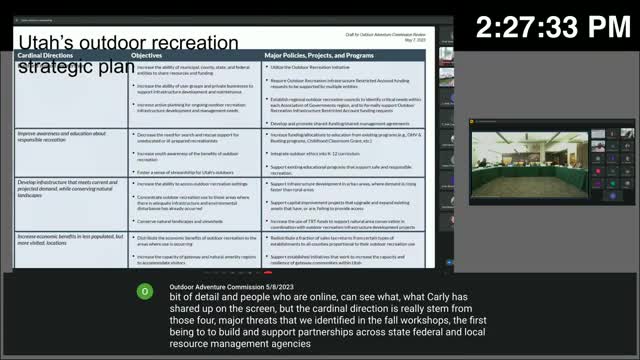Utah workshop outlines strategies for outdoor recreation infrastructure and economic growth
March 31, 2024 | Utah Outdoor Adventure Commission, Utah Department of Natural Resources, Utah Government Divisions, Utah Legislative Branch, Utah

This article was created by AI summarizing key points discussed. AI makes mistakes, so for full details and context, please refer to the video of the full meeting. Please report any errors so we can fix them. Report an error »

The Utah Outdoor Adventure Commission is taking significant steps to enhance outdoor recreation across the state, focusing on four key themes that emerged from recent workshops. The commission aims to improve awareness and education about responsible recreation, develop infrastructure to meet current and future demands, conserve natural landscapes, and increase economic benefits in less populated yet frequently visited areas.
During the meeting, members discussed the importance of distributing outdoor recreation use away from crowded national parks to less busy areas. Jason, a commission member, emphasized the need for infrastructure in these underutilized locations to accommodate growing demand. The commission is committed to identifying specific geographic areas where infrastructure is lacking, allowing for better access to outdoor activities while preserving remote destinations.
A critical point raised was the average duration of outdoor trips in the Central Wasatch, which is about 46 minutes. This statistic highlights the need for more accessible trails and resources, as most users prefer locations close to their homes. By concentrating development in areas with high demand, the commission believes it can enhance public access to outdoor recreation while protecting more secluded spots.
The discussion also touched on the economic implications of outdoor recreation. Some communities are eager to develop infrastructure to attract visitors, while others may prefer to limit access. The commission recognizes that 75% of Utah's population resides in four counties along the Wasatch Front, where most economic benefits from outdoor recreation currently flow. To address this imbalance, the commission is exploring policies and programs that empower rural communities to develop their outdoor assets according to their needs and interests.
As the commission moves forward, it aims to create a balanced approach that fosters outdoor recreation opportunities while respecting the desires of local communities. The anticipated outcomes include improved infrastructure, increased awareness, and enhanced economic benefits for less populated areas, ultimately enriching Utah's outdoor experience for all.
During the meeting, members discussed the importance of distributing outdoor recreation use away from crowded national parks to less busy areas. Jason, a commission member, emphasized the need for infrastructure in these underutilized locations to accommodate growing demand. The commission is committed to identifying specific geographic areas where infrastructure is lacking, allowing for better access to outdoor activities while preserving remote destinations.
A critical point raised was the average duration of outdoor trips in the Central Wasatch, which is about 46 minutes. This statistic highlights the need for more accessible trails and resources, as most users prefer locations close to their homes. By concentrating development in areas with high demand, the commission believes it can enhance public access to outdoor recreation while protecting more secluded spots.
The discussion also touched on the economic implications of outdoor recreation. Some communities are eager to develop infrastructure to attract visitors, while others may prefer to limit access. The commission recognizes that 75% of Utah's population resides in four counties along the Wasatch Front, where most economic benefits from outdoor recreation currently flow. To address this imbalance, the commission is exploring policies and programs that empower rural communities to develop their outdoor assets according to their needs and interests.
As the commission moves forward, it aims to create a balanced approach that fosters outdoor recreation opportunities while respecting the desires of local communities. The anticipated outcomes include improved infrastructure, increased awareness, and enhanced economic benefits for less populated areas, ultimately enriching Utah's outdoor experience for all.
View full meeting
This article is based on a recent meeting—watch the full video and explore the complete transcript for deeper insights into the discussion.
View full meeting

